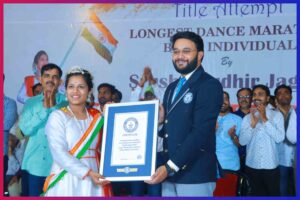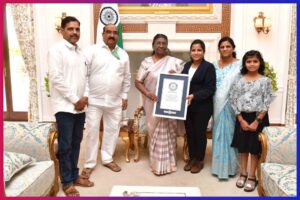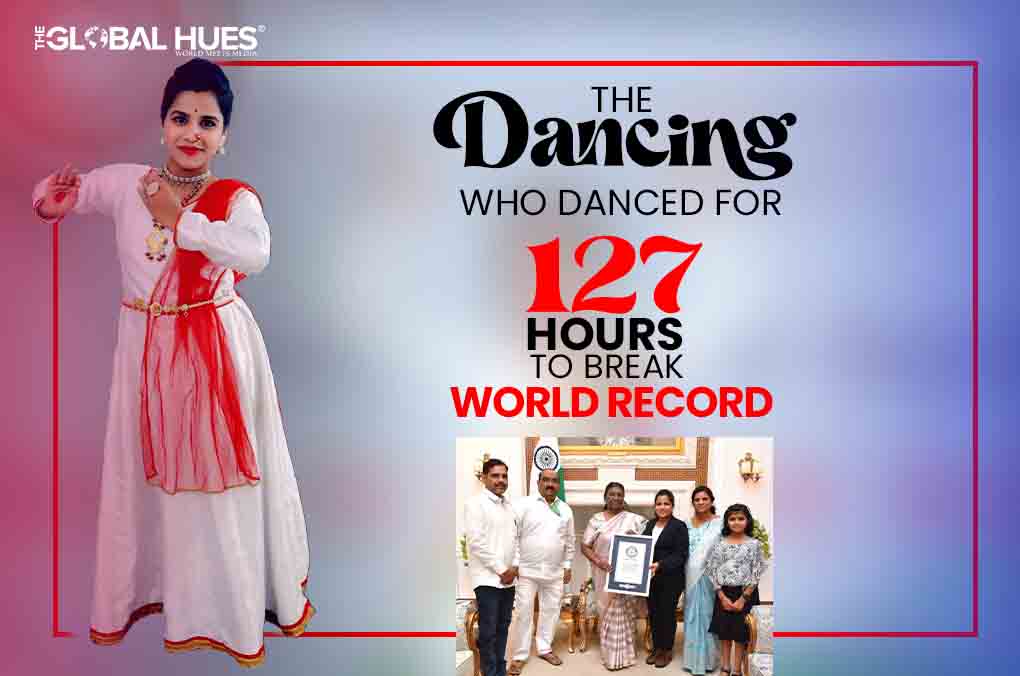When passion meets perseverance, records are not just broken but rewritten. Meet Srushti Sudhir Jagtap, a 17-year-old girl who danced her way into the Guinness World Records and made India proud by grooving continuously for 127 hours – that’s more than six days of non-stop dancing magic. Before Srushti, the record was 126 hours, held by another dancer named Bandana Nepal. But Srushti didn’t just break the record; she went above and beyond.
We connected with Srushti to know the inside scoop on what kept her going, how she got ready for such a dance marathon, and how she felt after she achieved what she wanted. Her dance theme was ‘Aazadi Ka Amrit Mahotsav,’ which made her performance not just a record-breaker but also a celebration of freedom and India’s rich culture.

How did you come up with the idea of breaking the Guinness World Record? How did you prepare for it?
I decided to participate in the Guinness World Record to showcase ‘Azadi ka Amrit Mohastav’. I wanted to do something for Mother India through my art. Back when I was in 7th and 8th grade, and also in the last year of my Kathak dance graduation during the lockdown, I found myself with a lot of free time after my online classes ended. Instead of getting bored, I wanted to do something meaningful with my art.
That’s when I found out about the Guinness Book of World Records, but there was an age rule– only those 16 and older could participate. So, I went for the Asia Book of Records and danced for 24 hours, which got my name in the record book. Also, during this time, I scored 99.2% in my 10th-grade CBSE exams.
Later, I decided to participate in the Guinness Book of World Records. It was a 15-month training, and my grandfather, a Yog Guru, helped me become mentally and physically strong through Yoga. I had to stay awake for six days to break the record, therefore I learnt Yog Nidra, a technique that helps you cover three to four hours of sleep in only three to four minutes.
My routine for those 15 months was fixed. I woke up at 3 AM, meditated, cycled 10 kilometres to my grandfather’s house to learn more exercises and Yoga, then went to the gym for another two hours of exercise and had to follow a strict diet. I also edited 127 hours of music for my performance. A team of 40 people, including doctors, choreographers, gymnasts, and physiotherapists, helped plan my strategy to break the record.
My parents supported me but when they looked into the history of people who tried to win in continuous dancing, they got scared. Before Bandana Nepal, two girls had attempted to do this; one of them died, and another ended up in a coma. However, I was determined to implement this and made plans accordingly. With the help of our family doctor, I took six months of Ayurvedic treatment to make my body healthier.
Along with diet and exercise, I practised the dance routine for 24 hours on the first day, and on the sixth day, I did the demo two times. The first time I danced for 20 hours, my ankles pained so much. My parents took me to the doctor, and he cautioned my parents that I shouldn’t dance for long hours since I wasn’t even 18 and my bones hadn’t matured. The dance practice was only half the battle, as the other half was getting selected for the Guinness Book of World Records.
Getting into the Guinness Book of World Records was tough. They get hundreds of thousands of applications daily. I got the date for my video conference on 3rd June. As the competition date neared, I did another round of demos where I danced non-stop for 24 hours. No breaks, not even for water. It was a test of my will. I mentally prepared myself with Brahma Kumari meditation.

The event took place in my college auditorium. People from Maharashtra supported and cheered for me. After winning, President Draupadi Murmu called me to meet her. Being called ‘Bharat Kanya,’ by her was a dream come true.
What was going on in your mind before you went on the stage to make the record?
When you look at it, my record was for nine days because I couldn’t sleep three days before the event. The people from the Guinness Book wanted the stage in a particular way, and I had to request them to include the Azadi ka Amrit Mahostav logo– thankfully, they agreed. As I was feeling restless, my parents locked me in a room so that I could get some sleep but I couldn’t. I kept calling them to check on the setup.
Before the event, someone asked me how I would have felt if I hadn’t broken the record. Strangely, I never dwelled on that thought. I was so focused on giving my best that the idea of not breaking the record didn’t even cross my mind. On the last day, I started having hallucinations and I took a five-minute break. After breaking the record, I had to wait for the certificate as a member of the Guinness Book Committee checked the recording to make sure that everything was in order.
How important has been the support of your family, especially your parents and grandfather, in your entire dance journey?
Whatever I am today is all because of them. They motivated me to do what I wanted to do. My father is a school teacher. After school, he would take me to my dance lessons, and we would reach home by ten at night. Their support meant a lot to me. I aim to crack the UPSC exam and become a collector so that my parents can proudly say that they are the parents of a ‘collector.’
Message from Shrushti Sudhir Jagtap
I advise people to figure out what they want to do in life and then believe in themselves. Dream big, and believe in your potential. Let your dedication and hard work do the talking. Self-belief is the key to success.
Read More Stories:
- Alaknanda Das: The Kathak Genius Who Danced Through Cancer
- Deepa Malik: A Woman With Limitless Spirits
- Aruna Desai: Embracing Motherhood Like No Other
- Ekta Viiveck Verma: The Catalyst For Change In Gender-Based Violence
- Deepika Mhatre: The House-Maid Turned Comedian



